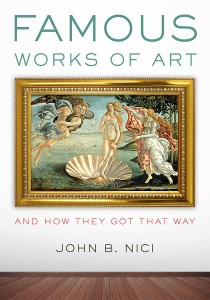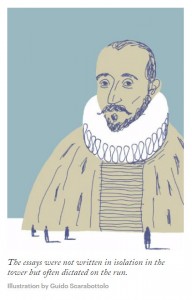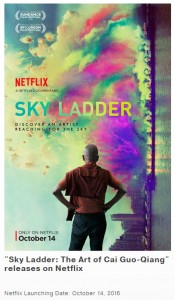 The title is actually “Famous Works of Art and How They Got That Way“. Of the book in question, that is.
The title is actually “Famous Works of Art and How They Got That Way“. Of the book in question, that is.
I don’t even know how the general topic came up in a recent conversation with Janet*, but it led to my memory of how a freshman college philosophy course (one of my very favorites, and one of my most memorable courses, ever) dealt with the “big questions” in philosophy. One was Art: What is it? What does it mean? Etc. And I told Janet that from that time on in 1959, I continued to ask myself such questions, and have repeatedly discussed the topic with friends and artists and others over many years.
Anyway. My latest read, retrieved from the local library, is the book mentioned above, authored by Queens College (New York) professor of art history, John B. Nici. The thing is turning out to be a fun, informative and entertaining page-turner that should appeal to anyone, whether the interest level is casual or serious, amateur or professional, or even almost absent. My only issue with the book is that it is printed in extremely small type (cramming a lot into just under 300 pages) and is not exactly senior-eye-friendly. A Kindle version is available for sale, but not yet through the library.
Here’s a quote from the book’s introduction:
Why do certain works of art sustain or lose their fame? Become chucked or embraced? Be heralded for eternity, or flagged for immediate dismissal, only to float in the trash heap of the misbegotten forgotten, but then resurface to plaudits and near-universal acclaim? These are the central questions and preoccupations of this book.
*Oh, yeah … now I sort of remember. I walked in, as usual, carrying a camera. Janet was asking me about my photography and photographs and that somehow triggered the question about whether photography could be considered “art”. Whereupon I said that photography could be thought of (in terms of the activity) as simply a possible tool for making art, that (in terms of the product or even process) it might depend on the creator’s intention. And then there is the whole business about process, let alone the separate questions of what is “good” art and what is “bad” art — and that got us into waxing philosophical …
 If you happened to have found interesting the essays and life philosophy of Michel de Montaigne that I fell into last August with Sarah Bakewell’s How To Live, you might want to read Adam Gopnik’s “Montaigne on Trial” in the January 16, 2017 issue of The New Yorker.
If you happened to have found interesting the essays and life philosophy of Michel de Montaigne that I fell into last August with Sarah Bakewell’s How To Live, you might want to read Adam Gopnik’s “Montaigne on Trial” in the January 16, 2017 issue of The New Yorker.







